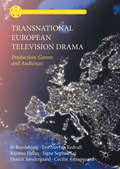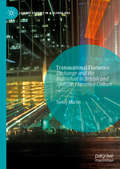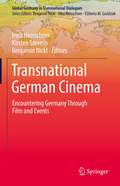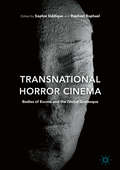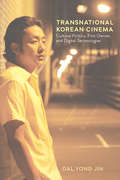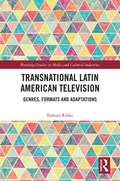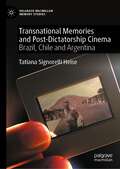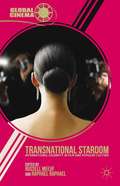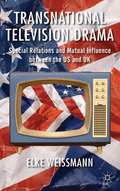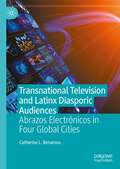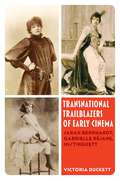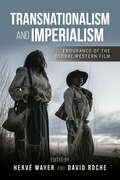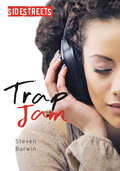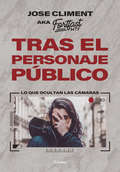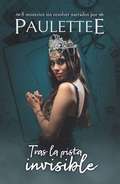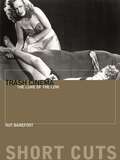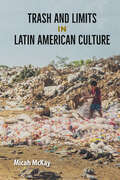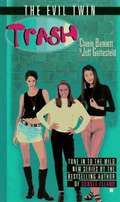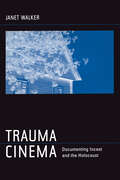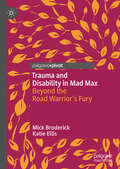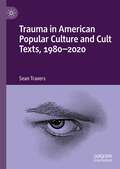- Table View
- List View
Transnational European Television Drama
by Eva Novrup Redvall Ib Bondebjerg Rasmus Helles Signe Sophus Lai Henrik Søndergaard Cecilie AstrupgaardThis book deals with the role of television drama in Europe as enabler of transnational, cultural encounters for audiences and the creative community. It demonstrates that the diversity of national cultures is a challenge for European TV drama but also a potential richness and source of creative variation. Based on data on the production, distribution and reception of recent TV drama from several European countries, the book presents a new picture of the transnational European television culture. The authors analyse main tendencies in television policy and challenges for national broadcasters coming from new global streaming services. Comparing cases of historical, contemporary and crime drama from several countries, this study shows the importance of creative co-production and transnational mediated cultural encounters between national cultures of Europe.
Transnational Flamenco: Exchange and the Individual in British and Spanish Flamenco Culture (Leisure Studies in a Global Era)
by Tenley MartinThis book provides insight into how flamenco travels, the forms it assumes in new locales, and the reciprocal effects on the original scene. Utilising a postnational approach to cultural identity, Martin explores the role of non-native culture brokers in cultural transmission. This concept, referred to as ‘cosmopolitan human hubs’, builds on Kiwan and Meinhof’s ‘hubs’ theory of network migration to move cultural migration and globalisation studies forwards. Martin outlines a post-globalisation flamenco culture through analysis of ethnographic research carried out in the UK, Sevilla and Madrid. Insight into these glocal scenes characterises flamenco as a historically globalized art complex, represented in various hubs around the world. This alternative approach to music migration and globalisation studies will be of interest to students and scholars across leisure studies, musicology, sociology and anthropology.
Transnational German Cinema: Encountering Germany Through Film and Events (Global Germany in Transnational Dialogues)
by Kirsten Stevens Benjamin Nickl Irina HerrschnerThis volume explores the notion of German cinema as both a national and increasingly transnational entity. It brings together chapters that analyse the international circuits of development and distribution that shape the emerging films as part of a contemporary “German cinema”, the events and spectacles that help frame and re-frame national cinemas and their discoverability, and the well-known filmmakers who sit at the vanguard of the contemporary canon. Thereby, it explores what we understand as German cinema today and the many points where this idea of national cinema can be interrogated, expanded and opened up to new readings. At the heart of this interrogation is a keen awareness of the technological, social, economic and cultural changes that have an impact on global cinemas more broadly: new distribution channels such as streaming platforms and online film festivals, and audience engagement that transcends national borders as well as the cinema space. International film production and financing further heightens the transnational aspects of cinema, a quality that is often neglected in marketing and branding of the filmic product. With particular focus on film festivals, this volume explores the tensions between the national and transnational in film, but also in the events that sit at the heart of global cinema culture. It includes contributions from filmmakers, cultural managers and other professionals in the field of film and cinema, as well as scholarly contributions from academics researching popular culture, film, and events in relation to Germany.
Transnational Horror Across Visual Media: Fragmented Bodies (Routledge Research in Cultural and Media Studies #55)
by Dana Och Kirsten StrayerThis volume investigates the horror genre across national boundaries (including locations such as Africa, Turkey, and post-Soviet Russia) and different media forms, illustrating the ways that horror can be theorized through the circulation, reception, and production of transnational media texts. Perhaps more than any other genre, horror is characterized by its ability to be simultaneously aware of the local while able to permeate national boundaries, to function on both regional and international registers. The essays here explore political models and allegories, questions of cult or subcultural media and their distribution practices, the relationship between regional or cultural networks, and the legibility of international horror iconography across distinct media. The book underscores how a discussion of contemporary international horror is not only about genre but about how genre can inform theories of visual cultures and the increasing permeability of their borders.
Transnational Horror Cinema
by Sophia Siddique Raphael RaphaelThis book broadens the frameworks by which horror is generally addressed. Rather than being constrained by psychoanalytical models of repression and castration, the volume embraces M. M. Bakhtin's theory of the grotesque body. For Bakhtin, the grotesque body is always a political body, one that exceeds the boundaries and borders that seek to contain it, to make it behave and conform. This vital theoretical intervention allows Transnational Horror Cinema to widen its scope to the social and cultural work of these global bodies of excess and the economy of their grotesque exchanges. With this in mind, the authors consider these bodies' potentials to explore and perhaps to explode rigid cultural scripts of embodiment, including gender, race, and ability.
Transnational Horror Cinema: Bodies of Excess and the Global Grotesque
by Sophia Siddique and Raphael RaphaelThis book broadens the frameworks by which horror is generally addressed. Rather than being constrained by psychoanalytical models of repression and castration, the volume embraces M.M. Bakhtin’s theory of the grotesque body. For Bakhtin, the grotesque body is always a political body, one that exceeds the boundaries and borders that seek to contain it, to make it behave and conform. This vital theoretical intervention allows Transnational Horror Cinema to widen its scope to the social and cultural work of these global bodies of excess and the economy of their grotesque exchanges. With this in mind, the authors consider these bodies’ potentials to explore and perhaps to explode rigid cultural scripts of embodiment, including gender, race, and ability.
Transnational Korean Cinema: Cultural Politics, Film Genres, and Digital Technologies
by Dal Yong JinIn Transnational Korean Cinema author Dal Yong Jin explores the interactions of local and global politics, economics, and culture to contextualize the development of Korean cinema and its current place in an era of neoliberal globalization and convergent digital technologies. The book emphasizes the economic and industrial aspects of the story, looking at questions on the interaction of politics and economics, including censorship and public funding, and provides a better view of the big picture by laying bare the relationship between film industries, the global market, and government. Jin also sheds light on the operations and globalization strategies of Korean film industries alongside changing cultural policies in tandem with Hollywood’s continuing influences in order to comprehend the power relations within cultural politics, nationally and globally. This is the first book to offer a full overview of the nascent development of Korean cinema.
Transnational Latin American Television: Genres, Formats and Adaptations (Routledge Studies in Media and Cultural Industries)
by Nahuel RibkeThis book examines the process of transnationalization of Latin American television industries. Drawing upon six representative case studies spanning the subcontinent’s vast and diverse geo-political and cultural landscape, the book offers a unique exploration of the ongoing formation of interrelated cultural, technological, and political landscapes, from the mid-1980s to the present. The chapters analyse the international circulation of the genres and formats of entertainment television across the subcontinent to explore the main driving forces propelling the production and consumption of television contents in the region, and what we can learn about the cultural and social identities of Latin American audiences following the journey of genres, formats, and media personalities beyond their own national borders. Taking a contemporary interdisciplinary approach to the study of transnational television industries, this book will be of significant interest to scholars and students of television and film studies, communication studies, Latin American studies, global media studies, and media and cultural industries.
Transnational Memories and Post-Dicatorship Cinema: Brazil, Chile and Argentina (Palgrave Macmillan Memory Studies)
by Tatiana Signorelli HeiseThis book investigates the role that cinemas in Brazil, Chile and Argentina have played in reconstructing memories of the most recent military dictatorships. These countries have undergone a distinctive post-dictatorship experience marked by unprecedented debates about human rights violations, the silencing of victims and accountability for state crimes. Meanwhile, politically committed filmmakers have created an extensive body of work addressing the dictatorship and its aftermath. This book employs a transnational and comparative approach to examine the strategies that these filmmakers have used to render visible what has remained hidden, to make reappear what has disappeared, and to reinterpret historical actors and events from a contemporary perspective. Through attention to the specific properties of the medium and the socio-historical context in which films have been made, it describes the different cinematic modes of remembering that emerged in response to wider memory frameworks in South America.
Transnational Screen Culture in Scandinavia: Mediating Regional Space and Identity in the Øresund Region (Palgrave European Film and Media Studies)
by Pei-Sze ChowThis book explores a range of lesser-known documentaries and short films from the transnational Øresund region released in the period 2000–2009, focusing on how this Scandinavian region’s urban and maritime spaces, iconic architecture, and peripheral communities across Malmö and Copenhagen have been imagined and critiqued through film. This is the first book to widen the critical gaze beyond popular representations to examine a significant body of peripheral films produced in and about the metropolitan Øresund region. Emerging at a time of spatial transformation and geopolitical change, these films weave alternative narratives that confront the official rhetoric of transnational regionalism. Offering the concept of regioscape as a way to investigate the intimate relationship between artistic representation, screen policy, space, and the region-building project, this book presents new readings of films by contemporary Swedish and Danish filmmakers such as Fredrik Gertten, Kolbjörn Guwallius, Daniel Dencik, and Max Kestner.
Transnational Stardom
by Russell Meeuf Raphael RaphaelThanks to the globalization of media, stars and celebrities are increasingly important figures in the transnational circulation of not only films but also ideas about identity and personhood. Combining a diverse range of case studies with an innovative collaborative discussion between leading scholars in star studies and transnational cinema, this book analyzes stars as sites of cross-cultural contestation. The contributors examine the phenomenon of global stardom as an important locus to help individualsbetter understand the construction of gender, race, nationality, and the individual as well as the importance of stars within transnational film industries. In a world in which cinema and its audiences are increasingly mobile, the essays in this collection explore how the plasticity of stars may help disparate peoples manage the shifting ideologies of a transnational world.
Transnational Television Drama
by Elke WeissmannThis history of British and American television drama since 1970 charts the increased transnationalisation of the two production systems. From The Forsyte Saga to Roots to Episodes , it highlights the close relationship that drives innovation and quality on both sides of the Atlantic.
Transnational Television and Latinx Diasporic Audiences: Abrazos Electrónicos in Four Global Cities
by Catherine L. BenamouThis book is based on a mixed-method, longitudinal study of the transmission, production, and reception of Spanish- and Portuguese-language television in four global cities with expanding Latinx diasporic populations. The author tracks and analyzes the production practices of Spanish-language broadcasters, the highlights of news and cultural affairs coverage, changes in the shooting locations and sociocultural discourses of telenovelas (both imported from Latin America and domestically produced), the presence of SLTV in the national political sphere, and the modes of media access and opinions of over 400 viewers in Detroit, Los Angeles, Miami, and Madrid. The possibilities created by SLTV and PLTV for achieving a sense of enfranchisement are explored. Intended for a general, as well as academic reading audience.
Transnational Trailblazers of Early Cinema: Sarah Bernhardt, Gabrielle Réjane, Mistinguett (Cinema Cultures in Contact #5)
by Prof. Victoria Harriet DuckettA free ebook version of this title is available through Luminos, University of California Press’s Open Access publishing program. Visit www.luminosoa.org to learn more. At the forefront of the entertainment industries of the late nineteenth and early twentieth centuries were singular actors: Sarah Bernhardt, Gabrielle Réjane, and Mistinguett. Talented and formidable women with global ambitions, these performers forged connections with audiences across the world while pioneering the use of film and theatrics to gain international renown. Transnational Trailblazers of Early Cinema traces how these women emerged from the Parisian periphery to become world-famous stars. Building upon extensive archival research in France, England, and the United States, Victoria Duckett argues that, through intrepid business prowess and the use of early multimedia to cultivate their celebrity image, these three artists strengthened ties between countries, continents, and cultures during pivotal years of change.
Transnationalism and Imperialism: Endurance of the Global Western Film (New Directions in National Cinemas)
by David Roche Hervé MayerWhile Western films can be seen as a mode of American exceptionalism, they have also become a global genre. Around the world, Westerns exemplify colonial cinema, driven by the exploration of racial and gender hierarchies and the progress and violence shaped by imperialism.Transnationalism and Imperialism: Endurance of the Global Western Film traces the Western from the silent era to present day as the genre has circulated the world. Contributors examine the reception and production of American Westerns outside the US alongside the transnational aspects of American productions, and they consider the work of minority directors who use the genre to interrogate a visual history of oppression. By viewing Western films through a transnational lens and focusing on the reinterpretations, appropriations, and parallel developments of the genre outside the US, editors Hervé Mayer and David Roche contribute to a growing body of literature that debunks the pervasive correlation between the genre and American identity.Perfect for media studies and political science, Transnationalism and Imperialism reveals that Western films are more than cowboys; they are a critical intersection where issues of power and coloniality are negotiated.
Trap Jam (Lorimer SideStreets)
by Steven BarwinOlivia spends her nights drumming in a band, hanging out in clubs and drinking, and her days hungover at school. When her bandmate Lucas catches Olivia talking to her friend Raymond in the women's washroom, he beats up Raymond in a jealous rage. When Lucas tells Olivia that Raymond's criminal brother is looking for them for payback, they go on the run together. Lucas keeps Olivia drunk and off-balance, telling her he loves her and pressuring her to have sex with him. When Olivia finally discovers that the story about Raymond's brother is a lie, she realizes she has to get out of Lucas's obsessive trap. Distributed in the U.S by Lerner Publishing Group.
Tras el personaje público
by José ClimentJordi Carrillo de Albornoz (Jordi Wild), Amarna Miller, Rocío Vidal (La Gata de Schrödinger), Luis Miguel Amor (Revenant), Rocío Camacho, Paul Alone, Carlos Santana (DotCSV), Javier Ivanyer (eh!), Elena Bueno, Nekane, Lisa JusticeDark, Luis Montilla (profesor de instituto) y David de Sousa (creativo publicista) son los invitados a este coloquio. Tras el personaje público aborda los pensamientos y reflexiones de los protagonistas del escenario online a través de entrevistas íntimas: ¿cómo se percibe la sociedad desde un altar de cientos de miles de seguidores?, ¿cuál es el precio de la fama?, ¿qué hay tras el personaje público? Comunicadores que han encontrado en la exposición mediática su forma de ganarse la vida, profesionales publicitarios responsables de las principales campañas de nuestro país y el testimonio de un docente en plena transformación digital.
Tras la pista invisible: 8 misterios sin resolver narrados por Paulettee
by PauletteeUn libro para verdaderos Misters.. Una maleta abandonada en medio del zócalo en Ciudad de México, tres hermanos que salieron a la playa y nunca volvieron, la muerte de una reconocida actriz o el fatídico desenlace de una secta religiosa son apenas una parte de lo que los Misters podrán encontrar en Tras la pista invisible, el primer libro de relatos de Paulettee, la reina del misterio. La crítica ha dicho: 'Celebro y sigo el contenido digital de Paulettee desdesiempre porque tiene investigación y esfuerzo periodístico, y este libro es la prueba de ello: ocho historias, narradas de manera ágil, que dejarán los pelos de punta a quienes las lean. (Y a quienes aún tienen pelo, claro)'. Daniel Samper Ospina
Trash Cinema: The Lure of the Low (Short Cuts)
by Guy BarefootThis volume explores the lower reaches of cinema and its paradoxical appeal. It looks at films from the B-movies of the 1930s to the mockbusters of today, and from the New York underground to the genre variations of Turkey's Yesilçam studios (and their YouTube afterlife). Critically examining the reasons for studying, denigrating, or celebrating the detritus of film history, it also considers the place of a trash aesthetic within and beyond 1960s American avant-garde and looks at the cult of trash in the fanzines of the 1980s. It draws on debates about cult, paracinema, and camp, arguing that trash cinema exists in relation to these but brings with it a particular history that includes the ordinary as well as the strange. Trash Cinema places these debates, and the strand of self-proclaimed low culture that emerged in the second half of the twentieth century, within a historical and international perspective. It focuses on American cinema history but addresses Eurotrash reception as well as the related field of garbology, examining trash cinema as a distinct but fluid category.
Trash and Limits in Latin American Culture
by Micah McKayThe ecological, social, and aesthetic functions of garbage in literature and film from Argentina to Mexico This book looks at the role of waste in Latin American cultural texts from the twentieth and twenty-first centuries and makes the case for foregrounding trash as an object of analysis in literary and cultural studies in Spanish America and Brazil. By considering how writers and filmmakers engage with the theme, Micah McKay argues that garbage illuminates key limits related to the region’s experience with contemporary capitalism. Recognizing trash as an important social reality, McKay traces its appearance in a diverse range of products: novels and documentary films with dumps as settings, short stories whose main characters are garbage pickers, and works that portray writing as a process of piecing together found materials. McKay argues that waste and the problems it poses are key to understanding marginalization, political struggle, and the production of aesthetic value. Drawing on insights from material ecocriticism, discard studies, and biopolitics, McKay theorizes that trash opens a space of reflection on what it means to be human, the possibilities for building community amid catastrophe, gendered notions of labor and care, and the pitfalls of neoliberal environmentalism. McKay shows how trash in literature and film helps readers and viewers contemplate the limits of how we inhabit the planet. Publication of this work made possible by a Sustaining the Humanities through the American Rescue Plan grant from the National Endowment for the Humanities.
Trash: A Queer Film Classic
by Jon DaviesTrash, one of three inaugural titles in Arsenal Pulp Press' new film book series Queer Film Classics, delves into the legendary 1970 film that was arguably the greatest collaboration between director Paul Morrissey and producer Andy Warhol.<P> The film Trash is a down-and-out domestic melodrama about a decidedly eccentric couple: Joe, an impotent junkie (played by Warhol film regular Joe Dallesandro), and Holly, Joe's feisty and sexually frustrated girlfriend (played by trans Warhol superstar Holly Woodlawn). Joe is the hunky yet passive center around whom proud Holly orbits; while Morrissey intended to show that "there's no difference between a person using drugs and a piece of refuse," Woodlawn's incredible turn reverses his logic: she makes trash as precious as human beings.<P> The book examines the film in the context of Morrissey and Warhol's legendary partnership, with a special focus on Woodlawn's acclaimed performance: a glorious embodiment of "trash" and glamour that was so stunning, director George Cukor led a campaign (albeit unsuccessful) to win her an Oscar nomination.
Trash: The Evil Twin
by Cherie Bennett Jeff GottesfeldCherie Bennett's thrilling series about interns who work for the trashiest TV talk show in history continues, as Chelsea's terrible secret is aired on national television--and Karma's family asks her to make a scary sacrifice!
Trauma Cinema: Documenting Incest and the Holocaust
by Janet WalkerTrauma Cinema focuses on a new breed of documentary films and videos that adopt catastrophe as their subject matter and trauma as their aesthetic. Incorporating oral testimony, home-movie footage, and documentary reenactment, these documentaries express the havoc trauma wreaks on history and memory. Janet Walker uses incest and the Holocaust as a double thematic focus and fiction films as a point of comparison. Her astute and original examination considers the Hollywood classic Kings Row and the television movie Sybil in relation to vanguard nonfiction works, including Errol Morris's Mr. Death, Lynn Hershman's video diaries, and the chilling genealogy of incest, Just, Melvin. Both incest and the Holocaust have also been featured in contemporary psychological literature on trauma and memory. The author employs theories of post traumatic stress disorder and histories of the so-called memory wars to illuminate the amnesias, fantasies, and mistakes in memory that must be taken into account, along with corroborated evidence, if we are to understand how personal and public historical meaning is made.Janet Walker’s engrossing narrative demonstrates that the past does not come down to us purely and simply through eyewitness accounts and tangible artifacts. Her incisive analysis exposes the frailty of memory in the face of disquieting events while her joint consideration of trauma cinema and psychological theorizing radically reconstructs the roadblocks at the intersection of catastrophe, memory, and historical representation.
Trauma and Disability in Mad Max: Beyond the Road Warrior’s Fury
by Katie Ellis Mick BroderickThis book explores the inter-relationship of disability and trauma in the Mad Max films (1979-2015). George Miller’s long-running series is replete with narratives and imagery of trauma, both physical and emotional, along with major and minor characters who are prominently disabled. The Mad Max movies foreground representations of the body – in devastating injury and its lasting effects – and in the broader social and historical contexts of trauma, disability, gender and myth.Over the franchise’s four-decade span significant social and cultural change has occurred globally. Many of the images of disability and trauma central to Max’s post-apocalyptic wasteland can be seen to represent these societal shifts, incorporating both decline and rejuvenation. These shifts include concerns with social, economic and political disintegration under late capitalism, projections of survival after nuclear war, and the impact of anthropogenic climate change.Drawing on screen production processes, textual analysis and reception studies this book interrogates the role of these representations of disability, trauma, gender and myth to offer an in-depth cultural analysis of the social critiques evident within the fantasies of Mad Max.
Trauma in American Popular Culture and Cult Texts, 1980-2020
by Sean TraversThis book examines trauma in late twentieth- and twenty-first century American popular culture. Trauma has become a central paradigm for reading contemporary American culture. Since the early 1980s, an extensive range of genres increasingly feature traumatised protagonists and traumatic events. From traumatised superheroes in Hollywood blockbusters to apocalyptic-themed television series, trauma narratives abound. Although trauma is predominantly associated with high culture, this project shows how popular culture has become the most productive and innovative area of trauma representation in America. Examining film, television, animation, video games and cult texts, this book develops a series of original paradigms through which to understand trauma in popular culture. These include: popular trauma texts’ engagement with postmodern perspectives, formal techniques termed ‘competitive narration’, ‘polynarration’ and ‘sceptical scriptotherapy’, and perpetrator trauma in metafictional games.
